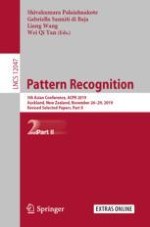2020 | Buch
Pattern Recognition
5th Asian Conference, ACPR 2019, Auckland, New Zealand, November 26–29, 2019, Revised Selected Papers, Part II
herausgegeben von: Shivakumara Palaiahnakote, Prof. Gabriella Sanniti di Baja, Liang Wang, Prof. Dr. Wei Qi Yan
Verlag: Springer International Publishing
Buchreihe : Lecture Notes in Computer Science
